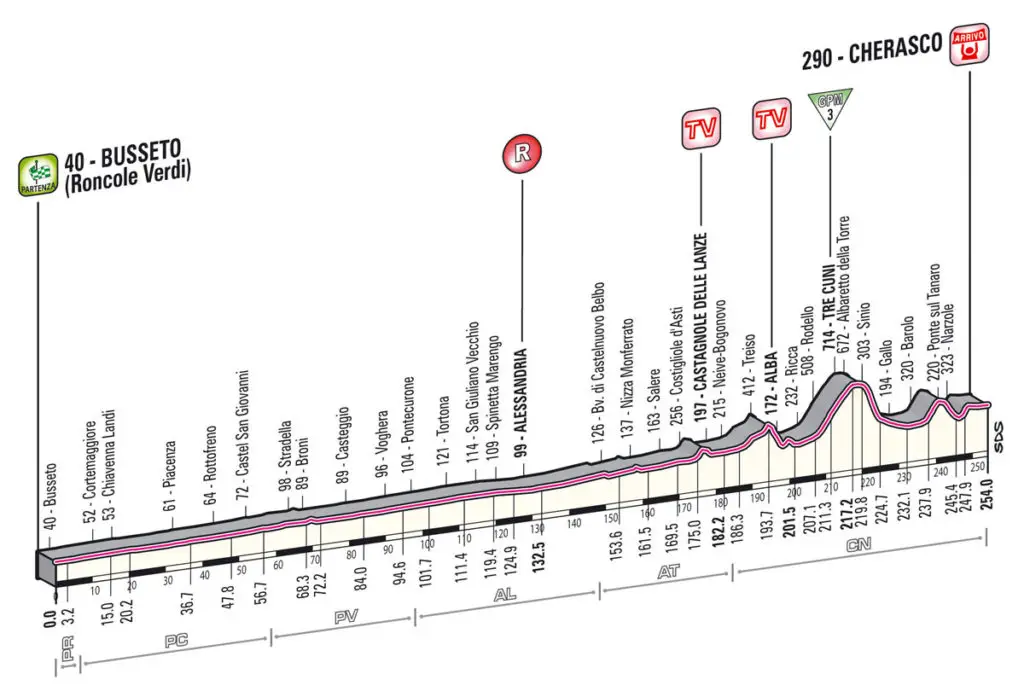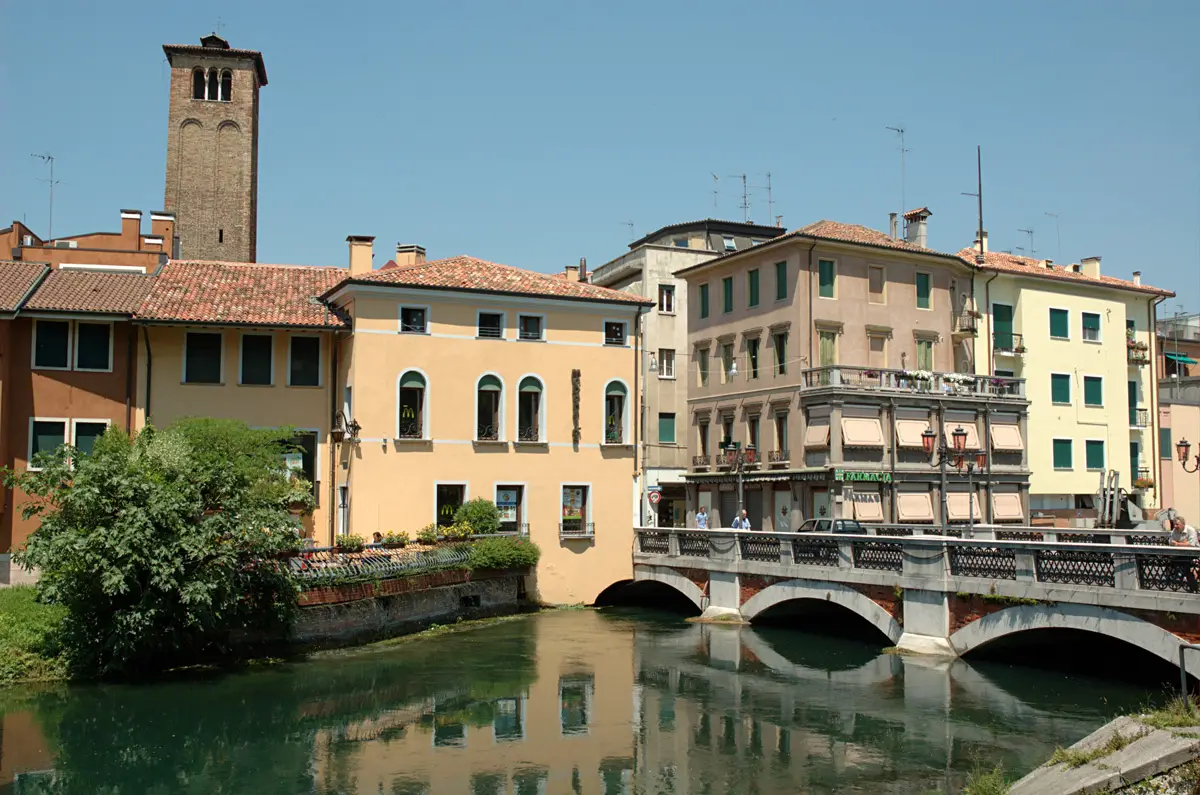Giro d’Italia 2013 Stage 12 is a mostly flat stage between Longarone and Treviso. The length of the course is 134 kilometers.

Previous stage: Giro d’Italia 2013 Stage 11 details

Next stage: Giro d’Italia 2013 Stage 13 details
Giro d’Italia 2013 Stage 12 quick info
DATE: May 16, 2013, Thursday
STAGE TYPE: Flat
START-FINISH: Longarone (440 m) > Treviso (11 m)
LENGTH OF THE COURSE: 134 km
DIFFICULTY:
Giro d’Italia 2013 Stage 12 Profile

Giro d’Italia 2013 Stage 12 Map

Last kilometers

Climbs


Start: Longarone

Longarone is a town and comune on the banks of the Piave in the province of Belluno, in North-East Italy.
The town was the site of a battle in World War I, in which a few companies of German troops led by Erwin Rommel successfully captured an entire Italian division of over 10,000, retreating after the Battle of Kobarid (Caporetto). Rommel was awarded his Pour le Mérite medal for this achievement.
The village was destroyed in the Vajont Dam disaster on October 9, 1963, when a landslide from Monte Toc forced 50 million cubic metres (1,800 million cu ft) of water over the top of the Vajont Dam. Longarone lay in the immediate path of the wave of mud and water which swept into the valley below. 1,909 villagers were killed.
Longarone was rebuilt following the tragedy and is now once again a thriving community.
Finish: Treviso

Treviso is a city and comune in Veneto, northern Italy. It is the capital of the province of Treviso and the municipality has 82,854 inhabitants (as of November 2010): some 3,000 live within the Venetian walls (le Mura) or in the historical and monumental center, some 80,000 live in the urban center proper, while the city hinterland has a population of approximately 170,000. The city is home to the headquarters of clothing retailer Benetton, appliance maker De’Longhi, and bicycle maker Pinarello.
Treviso is home to several notable Italian sport teams, thanks to the presence of the Benetton family, who owns and sponsors:
- Sisley Treviso (volleyball), winner of 9 scudetti, playing at the Palaverde.
- Benetton (rugby union), winner of 15 scudetti, playing at the Monigo stadium. Since the 2010–11 season, Benetton has been one of two Italian teams in the Pro14, alongside existing teams from Ireland, Scotland, and Wales.
- Benetton Basket, winner of 5 scudetti, playing at the Palaverde.
- The local football team, A.S.D. Treviso 2009
Architecture
- The Late Romanesque-Early Gothic church of San Francesco, built by the Franciscan community in 1231-1270. Used by Napoleonic troops as a stable, it was reopened in 1928. The interior has a single nave with five chapels. On the left wall is a Romanesque-Byzantine fresco portraying St. Christopher (later 13th century). The Grand Chapel has a painting of the Four Evangelists by a pupil of Tommaso da Modena (the Italian painter of the mid-14th century), to whom is instead directly attributed a fresco of Madonna with Child and Seven Saints (1350) in the first chapel on the left. The next chapel has instead a fresco with Madonna and Four Saints from 1351 by the so-called Master of Feltre. The church, among others, houses the tombs of Pietro Alighieri, son of the famous Italian poet Dante (c. 1265 – 1321), and Francesca Petrarca, daughter of the poet Francesco (July 20, 1304 – July 18/19, 1374, the Italian scholar and poet during the early Italian Renaissance).
- The Loggia dei Cavalieri, an example of Treviso’s Romanesque influenced by Byzantine forms. It was built under the podestà Andrea da Perugia (1276) as a place for meetings, talks, and games, although reserved only to the higher classes.
- Piazza dei Signori (Lords’ Square), with the Palazzo di Podestà (later 15th century).
- Church of San Nicolò, a mix of 13th-century Venetian Romanesque and French Gothic elements. The interior has a nave and two aisles, with five apsed chapels. It houses important frescoes by Tommaso da Modena, depicting St Romuald, St Agnes, and the Redemptor and St Jerome in his Study. Also, the Glorious Mysteries of Santo Peranda can be seen. Noteworthy is also the fresco of St Christopher on the eastern side of the church, which is the most ancient depiction in glass in Europe.
- Cathedral is dedicated to St Peter. It was once a small church built in the Late Roman era, to which later were added a crypt and the Santissimo and Malchiostro Chapels (1520). After the numerous later restorations, only the gate remains of the original Roman edifice. The interior houses are works by Il Pordenone and Titian (Malchiostro Annunciation) among others. The edifice has seven domes, five over the nave, and two closings the chapels.
- Palazzo dei Trecento, built in the 13th-14th centuries.
- Piazza Rinaldi. It is the seat of three palaces of the Rinaldi family, the first built in the 12th century after their flight from Frederick Barbarossa. The second, with unusual ogival arches in the loggia of the first floor, is from the 15th century. The third was added in the 18th century.
- Ponte di Pria (Stone Bridge), along the city walls, where River Botteniga divides into the three channels that cross the city centre (Cagnan Grande, Cagnan di Mezzo, Roggia).
- Monte di Pietà di Treviso and the Cappella dei Rettori. The Monte di Pietà was founded to house Jewish moneylenders. On the second floor is the Cappella dei Rettori, a lay hall for meetings, with frescoes by il Pozzoserrato.
- Teatro Mario Del Monaco, the main theatre and opera house of the city. It was built in 1869 to designs by Andrea Scala [it] which kept the theatre’s original facade. The internal decorations were by the painter Federico Andreotti (6 March 1847 – 1930) and the sculptor Fausto Asteo.
Sources
- Longarone on Wikipedia
- Treviso on Wikipedia


